Blooming from this free crochet tulip amigurumi pattern are all the sunny scenes of sweet springtime—the bitter air softening to a warm, fresh breeze, timid green buds peeking out from the ground, and trees redressing their cold limbs with new leaves.
While you bask in the fresh floral breeze of sunny springtime, there’s no better way to celebrate the rebirth of the earth than with this free crochet tulip amigurumi pattern!
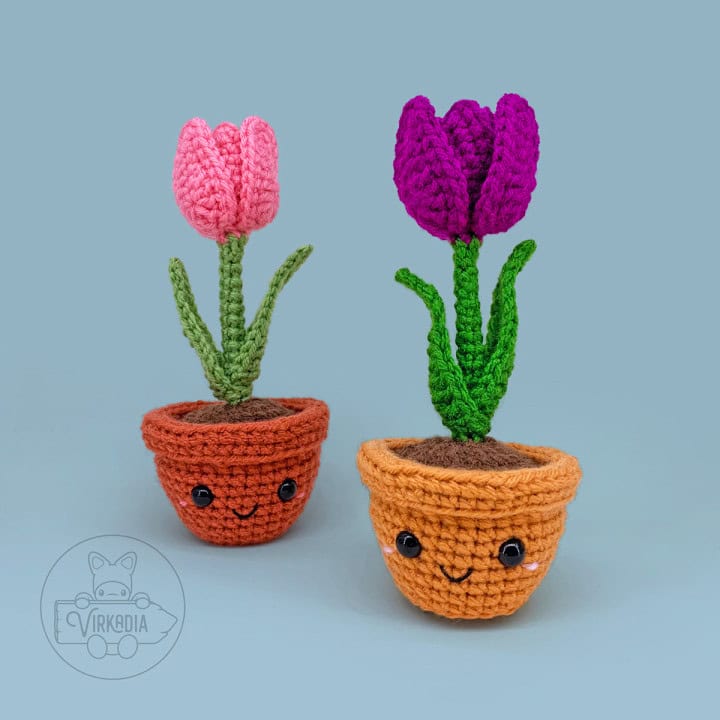
So, without further ado, here is the pattern for the Tulip Cutie, part 2 of 9 in the Flower Cuties collection!
Pattern Information | Free Crochet Tulip Amigurumi
This free crochet tulip amigurumi pattern has a difficulty rating of intermediate.
The finished dimensions are 8 inches (height) by 3.25 inches (width) by 3.25 inches (depth).*
You may also make your pieces larger or smaller by increasing or decreasing your yarn weight and/or hook size, respectively.
*Finished dimensions are calculated from a model using medium weight yarn, a size H-8 (5 mm) crochet hook, the YU/YO method and the following gauge: 18 sc x 21 rows = 4 inches.
And don’t forget to add your project on Ravelry!
Supplies:
- Size H-8 (5 mm) crochet hook
- Medium (4) weight yarn in 4 colors:
- Yarn A – brown (example uses Loops & Threads Soft Classic: Mocha)
- Yarn B – orange (example uses Caron One Pound: Faded Brick)
- Yarn C – purple (example uses Loops & Threads Soft Classic: Raspberry)
- Yarn D – green (example uses Big Twist Value: Forest Green)
- Pink embroidery floss or pink yarn (example uses Red Heart Super Saver: Baby Pink)
- Black embroidery floss
- 10mm black safety eyes (x2)
- Wire (example uses 14 Gauge Black Aluminum Wire by hildie & jo)
- Wire Cutters
- Polyester fiberfill
- Yarn needle
- Scissors
- Stitch markers
Alternate Yarn Supplies:
Color Variation 2 (as seen on the left in cover photo):
- Medium (4) weight yarn in 4 colors:
- Yarn A – brown (example uses Loops & Threads Soft Classic: Mocha)
- Yarn B – rust (example uses Loops & Threads Soft Classic: Ginger)
- Yarn C – pink (example uses Red Heart Super Saver: Perfect Pink)
- Yarn D – green (example uses Red Heart Super Saver: Tea Leaf)
- Pink embroidery floss or pink yarn (example uses Red Heart Super Saver: Perfect Pink)
Terminology:
This free crochet tulip amigurumi pattern uses English (US) terminology:
- st (sts) = stitch (stitches)
- ch = chain stitch
- sl st = slip stitch
- sc = single crochet
- sc2tog = single crochet 2 together (over the span of 2 stitches), also known as a decrease
- hdc = half double crochet
- dc = double crochet
- FLO = front loop only
- BLO = back loop only
- sk = skip
Please note that this pattern is written so that each crochet stitch abbreviation is attached to a number, such as 1sc, 2sc, etc. This number denotes how many of that stitch is to be worked into the same stitch.
You can learn more about how to read Virkadia patterns on our Pattern Help FAQ page!
Special Stitch Instructions:
Please review our special stitch instructions on our Stitch Tutorials FAQ before beginning, as some techniques may be unique to this pattern.
You can also watch our amigurumi techniques video tutorial for all of our tips and tricks for improving your project!
This free crochet tulip amigurumi pattern uses the following special stitch tutorials:
- Single Crochet (YU/YO Method)
- Invisible Decrease
- Joining Rounds
This pattern is worked in the round, with each round joined at the end with a slip stitch. Unless otherwise instructed, the first stitch of your next round will always be worked into the same stitch as your joining slip stitch has been worked into.
Be sure to always keep the ‘right side’ of your stitches facing outwards as you work. The right side is the front side of the stitch that is facing you as you are completing each stitch.
Pattern Instructions | Free Crochet Tulip Amigurumi
Crochet Tulip Petals:
With yarn C (purple), chain 7.
Rnd 1: beginning in 2nd ch from hook, *1sc into each of next 5 sts, 2sc into next st* working into other side of ch sts, repeat from * to * 1 time, sl st into 1st st to join, ch 1 (14).
Rnd 2: [1sc into each of next 6 sts, 2sc into next st] 2 times, join (16).
Fasten off yarn C and weave in ends. Set aside for now
Repeat rounds 1 and 2, two more times, for a total of three petals. These will be your inner petals.
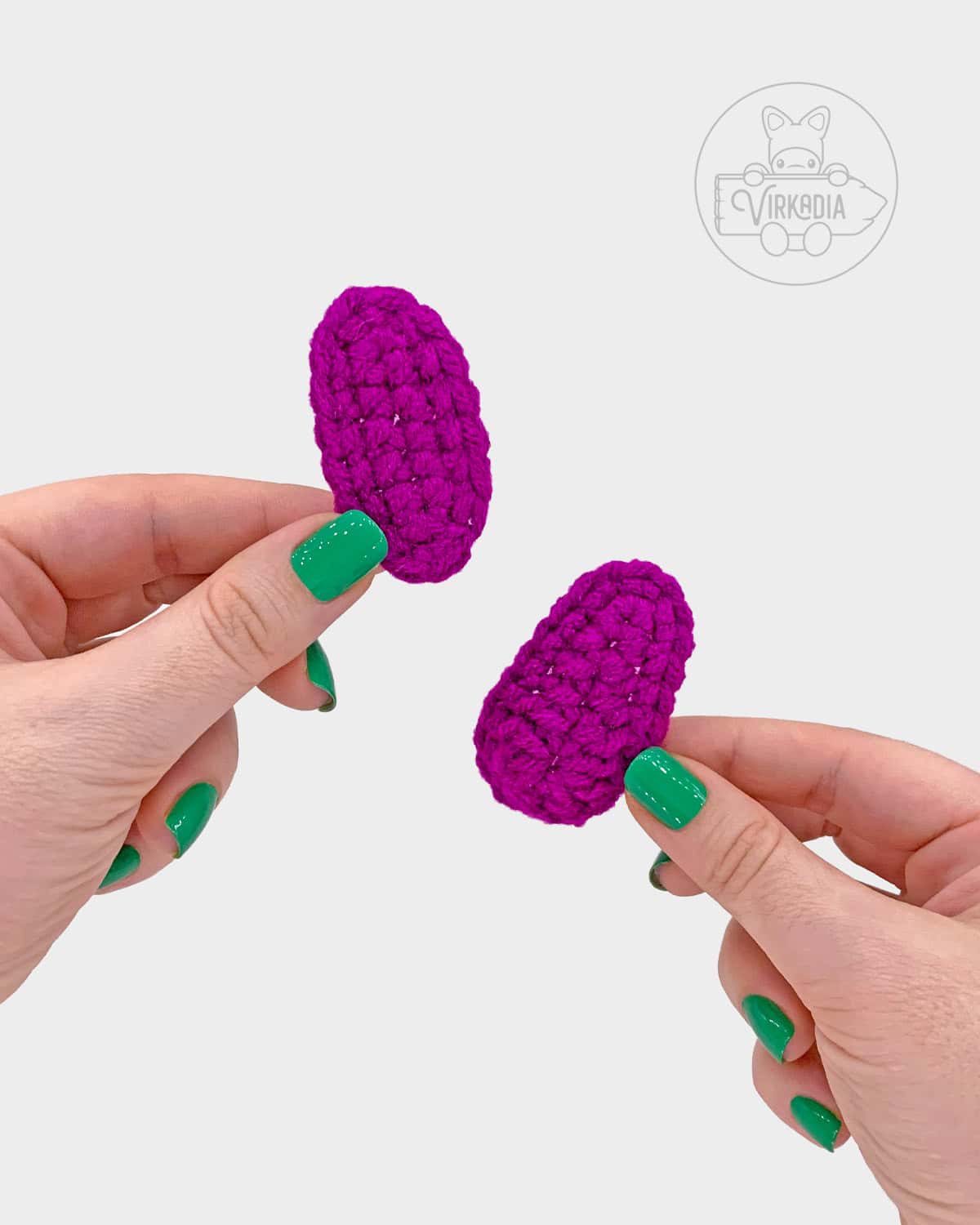
With yarn C (purple), chain 8.
Rnd 1: 3dc into 3rd ch from hook, 1dc into next st, 1hdc into each of next 2 sts, 1sc into next st, 2sc into next st, working into other side of ch sts, 1sc into each of next 2 sts, 1hdc into each of next 2 sts, 1dc into next st, 3dc into next st, sl st into 1st dc to join, ch 1 (17).
Rnd 2: 2sc into next st, 1sc into each of next 6 sts, 2sc into each of next 3 sts, 1sc into each of next 6 sts, 2sc into next st, join (22).
Fasten off yarn C and weave in ends. Set aside for now.
Repeat rounds 1 and 2, two more times, for a total of three petals. These will be your outer petals.
Crochet Tulip Leaves:
With yarn D (green), chain 13.
Rnd 1: sl st into 2nd ch from hook, sl st into each of next 2 sts, 1sc into each of next 3 sts, 1hdc into each of next 3 sts, 1dc into each of next 2 sts, (1dc, ch 3, sl st into same st as dc) into next st, ch 3, working into other side of ch sts, 1dc into each of next 3 sts, 1hdc into each of next 3 sts, 1sc into each of next 3 sts, sl st into each of next 3 sts, sl st into 1st st to join (31).
Fasten off yarn E and weave in tails. Set aside for now.
Repeat round 1, one more time, for a total of two leaves.

Crochet Tulip Stem:
With yarn C (purple), make a magic ring (or ch 4, sl st into 1st st to form ring, ch 1).
Rnd 1: 6sc into ring, sl st into 1st st to join, ch 1 (6).
Retrieve your all of your petals set aside earlier (3 inner petals and 3 outer petals).
You will now be working each stitch through one of your petals and your current round simultaneously in order to attach each petal to the stem.
You will attach your inner petals with round 2 of the stem, and your outer petals during round 3.
All petals should be laid over top of your current round with their ‘right sides’ facing you as you attach them.
Locate the last 2 stitches of round 2 of your inner petals. These will be the stitches you will work into to attach them to your stem during round 2.
Then, locate the first and last stitches of round 2 of your outer petals. During round 3, attach your outer petals using the same method, with the exception that each petal will be shifted 1 stitch sooner in the round.
Optionally, if you have difficulty attaching the petals in this way, you may instead sew them onto the stem afterwards with a length of yarn C.
If you choose to sew the petals on instead, simply replace round 2 and 3 of the stem with normal rounds (1sc into each st around, join).
Choose whichever method works best for you!
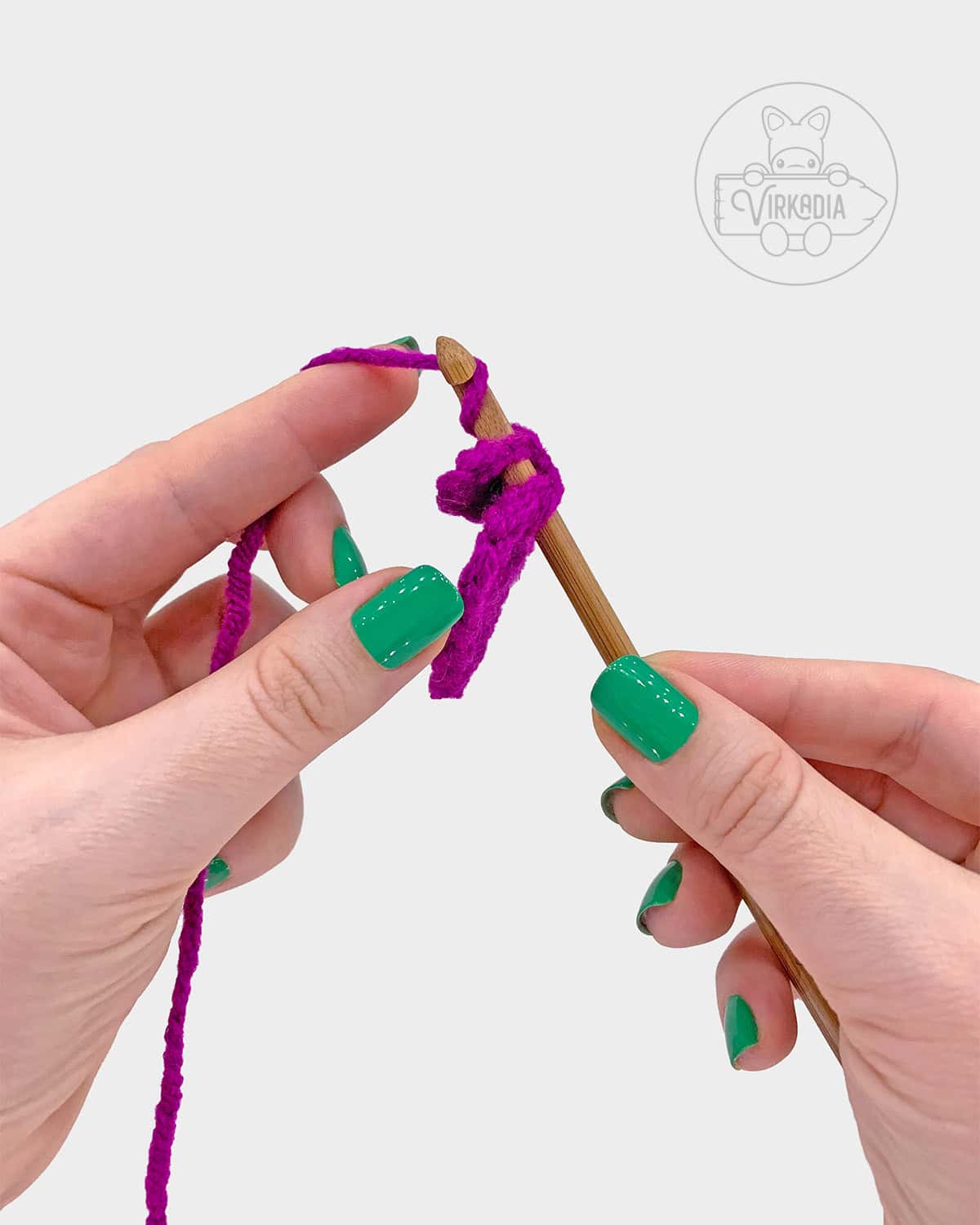
Rnd 2: [1sc into 2nd to last st of next petal and next st of stem together, 1sc into last st of same petal and next st of stem together] 3 times, join, ch 1 (6).
Rnd 3: 1sc into 1st st of 1st petal and next st of stem together, [1sc into last st of next petal and next st of stem together, 1sc into 1st st of same petal and next st of stem together] 2 times, 1sc into last st of 1st petal and next st of stem together, join (6).
Fasten off yarn C and leave a short tail for tying.
Join yarn D (green) by inserting your hook into the first stitch of your next round. Leaving a short tail for tying, pull up a loop of yarn D and ch 1.
Tie the tails of both yarn C and yarn D together on the interior of your piece to secure your ends.
The remainder of this crochet tulip stem is worked mainly in rounds of only 4 stitches each.
While this creates a nice, slim stem for your flower, it may be challenging for some crocheters to work into.
If you have difficulty working into small rounds, you may instead replace rounds 5 to 14 with continuing rounds of 6 stitches each (1sc into each st around, join).
Choose whichever method works best for you!
Rnd 4: 1sc into each st around, join, ch 1 (6).
Rnd 5: [1sc into next st, sc2tog over next 2 sts] 2 times, join, ch 1 (4).
Rnd 6: 1sc into each st around, join, ch 1 (4).
Rnd 7 to 13 (7 rnds): repeat rnd 5 (4).
Rnd 14: [1sc into next st, 2sc into next st] 2 times, join, ch 1 (6).
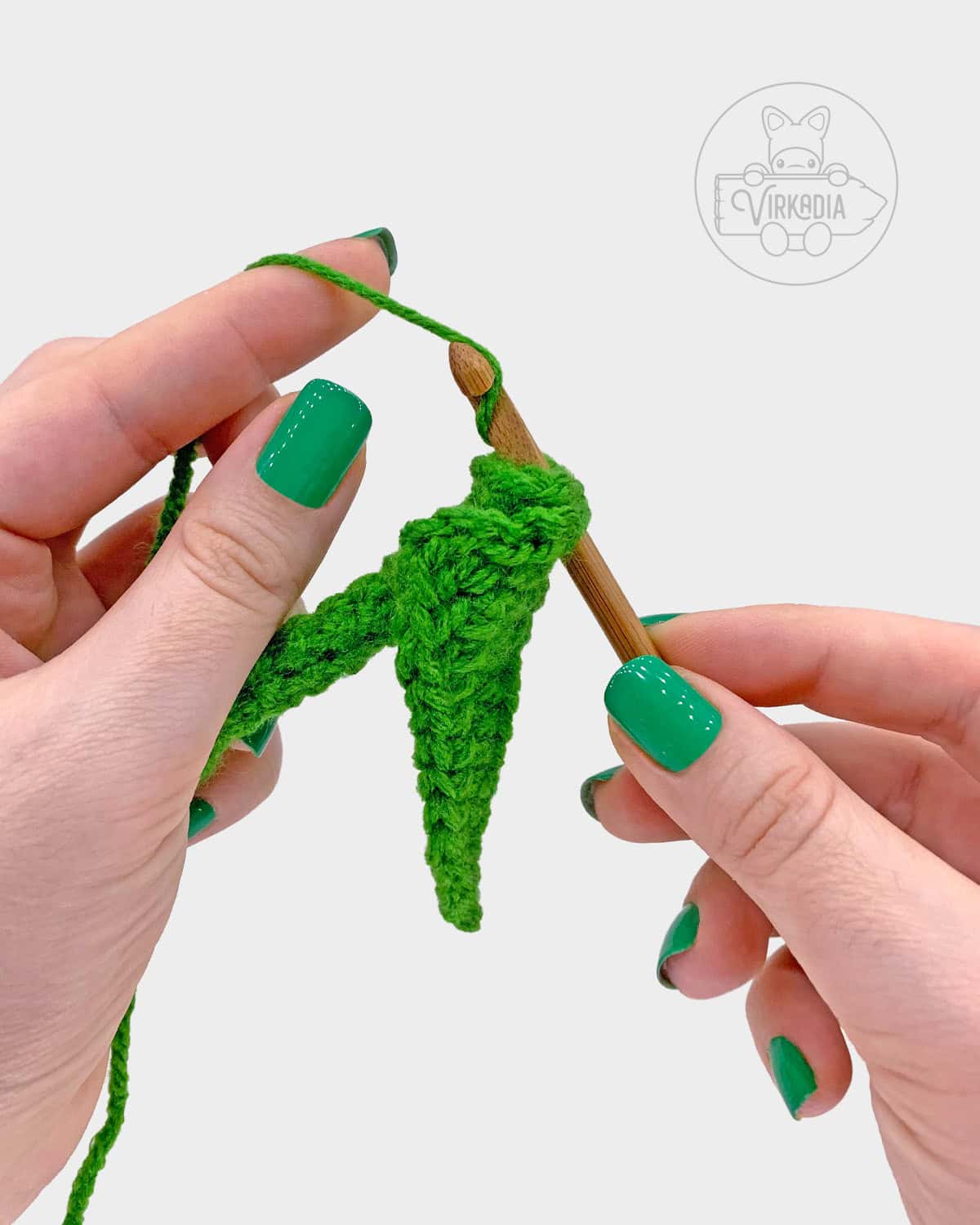
Retrieve your crochet tulip leaves set aside earlier.
Align your first leaf so that both of the 3-chain sequences (on the opposite side of your pointy end) are parallel with your current round.
You will be working round 15 through both the chain stitches of the leaf and the current round of the stem to attach them together.
Optionally, if you have difficulty attaching the leaves in this way (especially the second leaf, which is trickier), you may instead sew them onto the stem afterwards with a length of yarn D.
If you are choosing to sew the leaves instead, simply replace rounds 15 and 16 with normal rounds (1sc into each st around, join, ch 1).
Choose whichever method works best for you!
Rnd 15: 1sc into each st around of both leaf and stem together, join, ch 1 (6).
Rnd 16: 1sc into 4th ch of leaf and 1st st of stem together, 1sc into each of next 2 sts of both leaf and stem together, 1sc into 1st ch of leaf and 4th st of stem together, 1sc into each of next 2 sts of both leaf and stem together, join (6).
Fasten of yarn D and leave a short tail for tying.
If you skipped attaching the leaves during round 15 and 16, you may sew them on now.
Crochet Pot Dirt:
With yarn A (brown), leave a tail for sewing and chain 6. Slip stitch into the first chain to form a circle and chain 1.
Rnd 1: 2sc into each ch around, sl st into 1st st to join, ch 1 (12).
Rnd 2: [1sc into next st, 2sc into next st] 6 times, join, ch 1 (18).
Rnd 3: [2sc into next st, 1sc into each of next 2 sts] 6 times, join, ch 1 (24).
Rnd 4: [1sc into each of next 3 sts, 2sc into next st] 6 times, join, ch 1 (30).
Rnd 5: [2sc into next st, 1sc into each of next 4 sts] 6 times, join (36).

Fasten off yarn A and leave a long (~2 ft) tail for sewing.
Alternatively, you can also leave just a short end tail if you start the next section of your pot with a long beginning tail—either works!
Crochet Terracotta Pot:
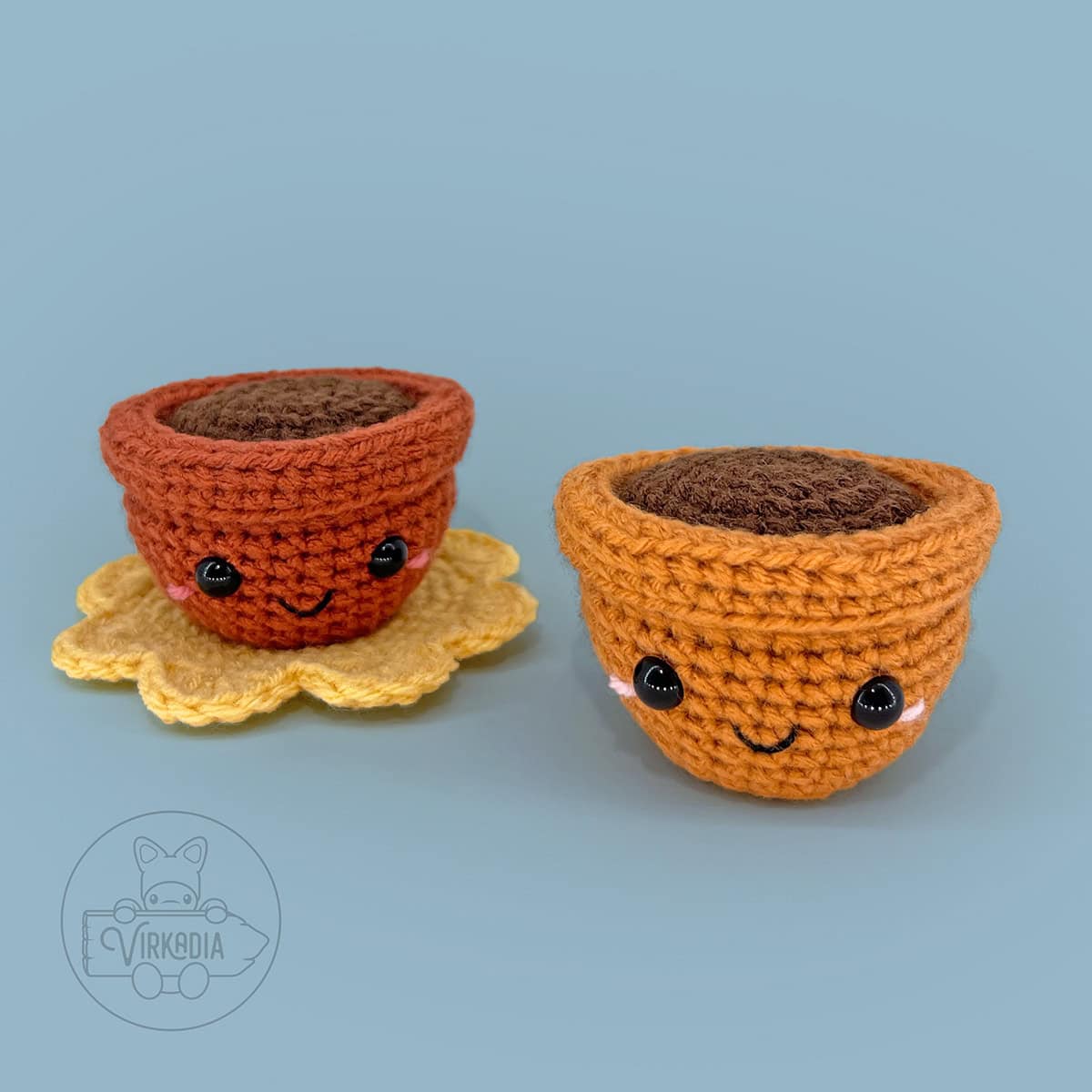
Follow the tutorial for the Terracotta Pot Cutie companion pattern before continuing to the next steps.
If desired, you may also substitute the terracotta pot with a Drip Glaze Pot Cutie—both pot patterns are compatible with all of our Flower Cuties and Plant Cuties!
The terracotta pot pattern, as seen in the photo above, is easier in difficulty than the drip glaze pot and is a great option for crocheters that are not comfortable with mid-round color changing and surface crochet techniques.
Conversely, the drip glaze pot pattern, as seen below, is more challenging but also has a wider base than the terracotta pot and makes your projects less prone to being top-heavy.
Choose whichever pattern works best for you!
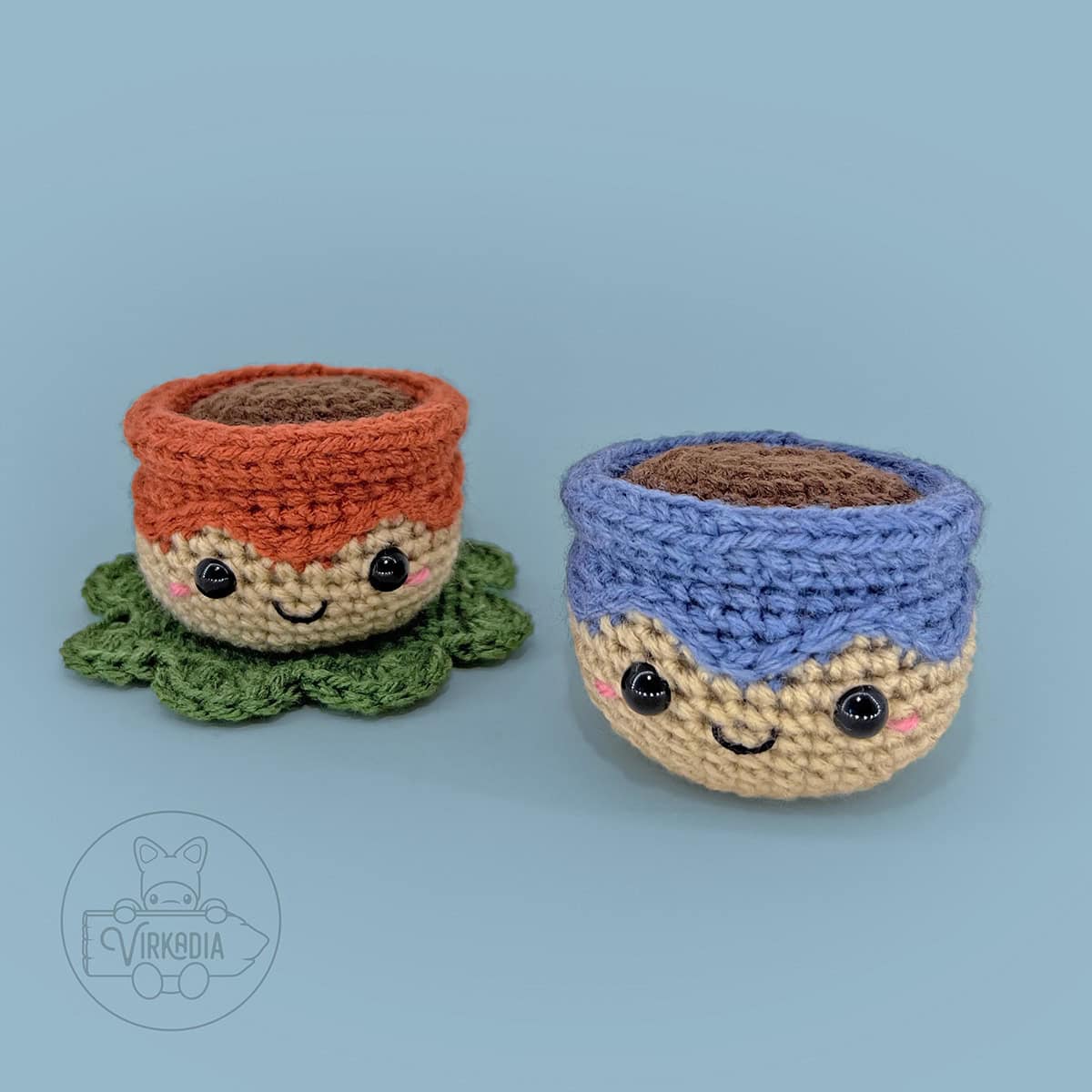
Crochet Tulip – Sewing Together:
Retrieve your tulip set aside earlier and place the bottom of the stem over top of the center hole (round 1) of your chosen flower pot.
Using the tail of yarn A left over from the beginning of the flower pot, sew around the entire circumference of the tulip stem and flower pot hole to attach them together.
Secure with a knot to the end tail of the stem, trim any excess length, and weave in tails.
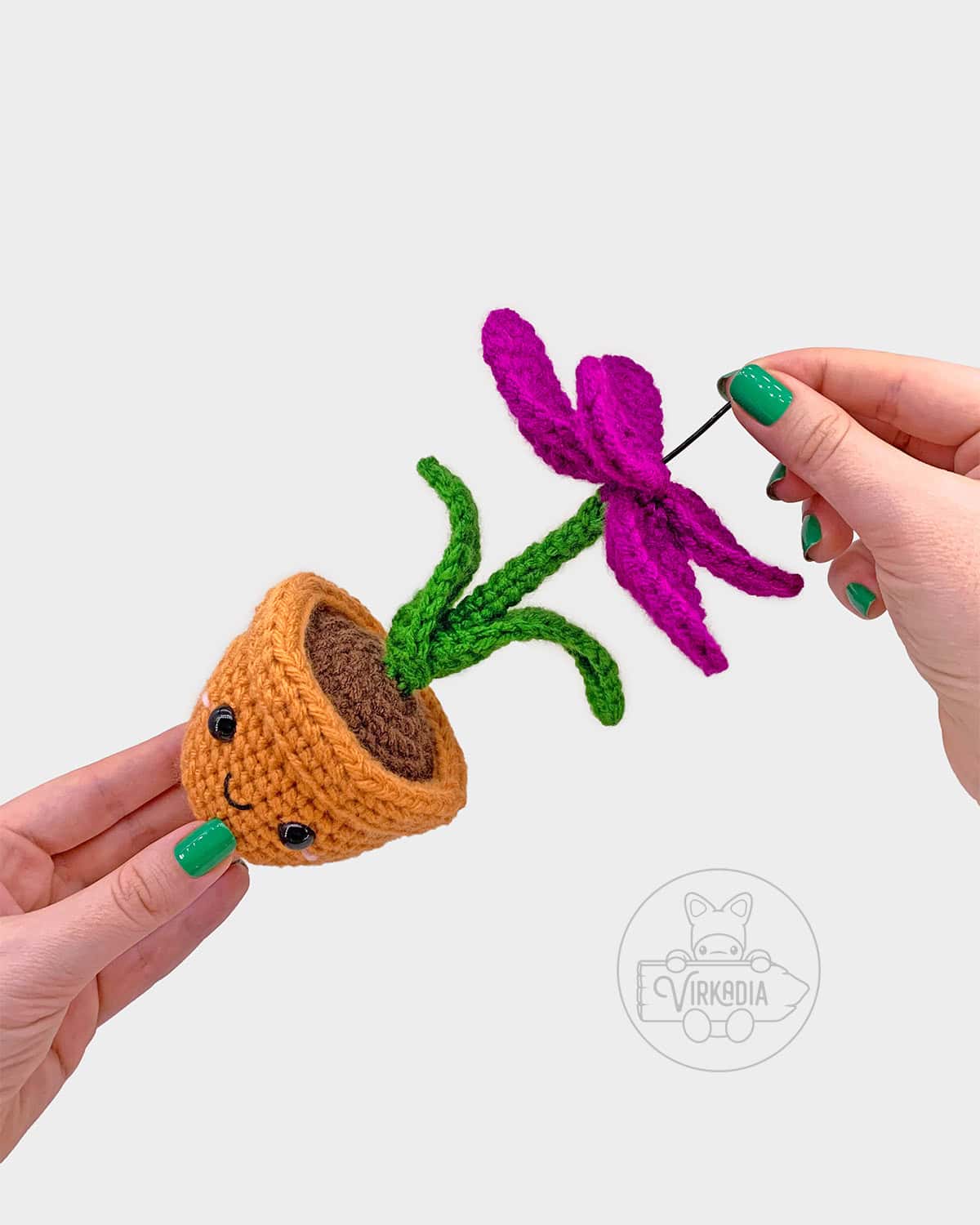
Finally, cut a length of wire to the height of your crochet tulip, from the bottom of the flower pot to the top of stem.
Gently thread the wire through the center of the flower and down the stem until it reaches the bottom of your crochet flower pot and your tulip is able to stand upright on its own.
Conclusion | Free Crochet Tulip Amigurumi
And with that, you’re done the free crochet Tulip Cutie pattern! If you enjoyed this pattern, be sure to check out its eight companion patterns in the Flower Cuties collection: the Daffodil Cutie, the Daisy Cutie, the Carnation Cutie, the Sunflower Cutie, the Rose Cutie, the Lily of the Valley Cutie, the Pansy Cutie, and the Lily Cutie!
You can also explore the Cutie Collections page and the Pocket Pets page for more original and free amigurumi patterns, or our Home Decor Patterns for other homemade household goodies!
If you’re looking to cozy up with a longer project, check out our Clothing Patterns, or assemble your own designs from one of our Granny Square Patterns!
And don’t forget to browse our downloadable, ad-free patterns in our Etsy store!
Follow Virkadia on Instagram to stay updated on all new and upcoming patterns, crochet content, and amigurumi adventures! Thank you for all of your support!
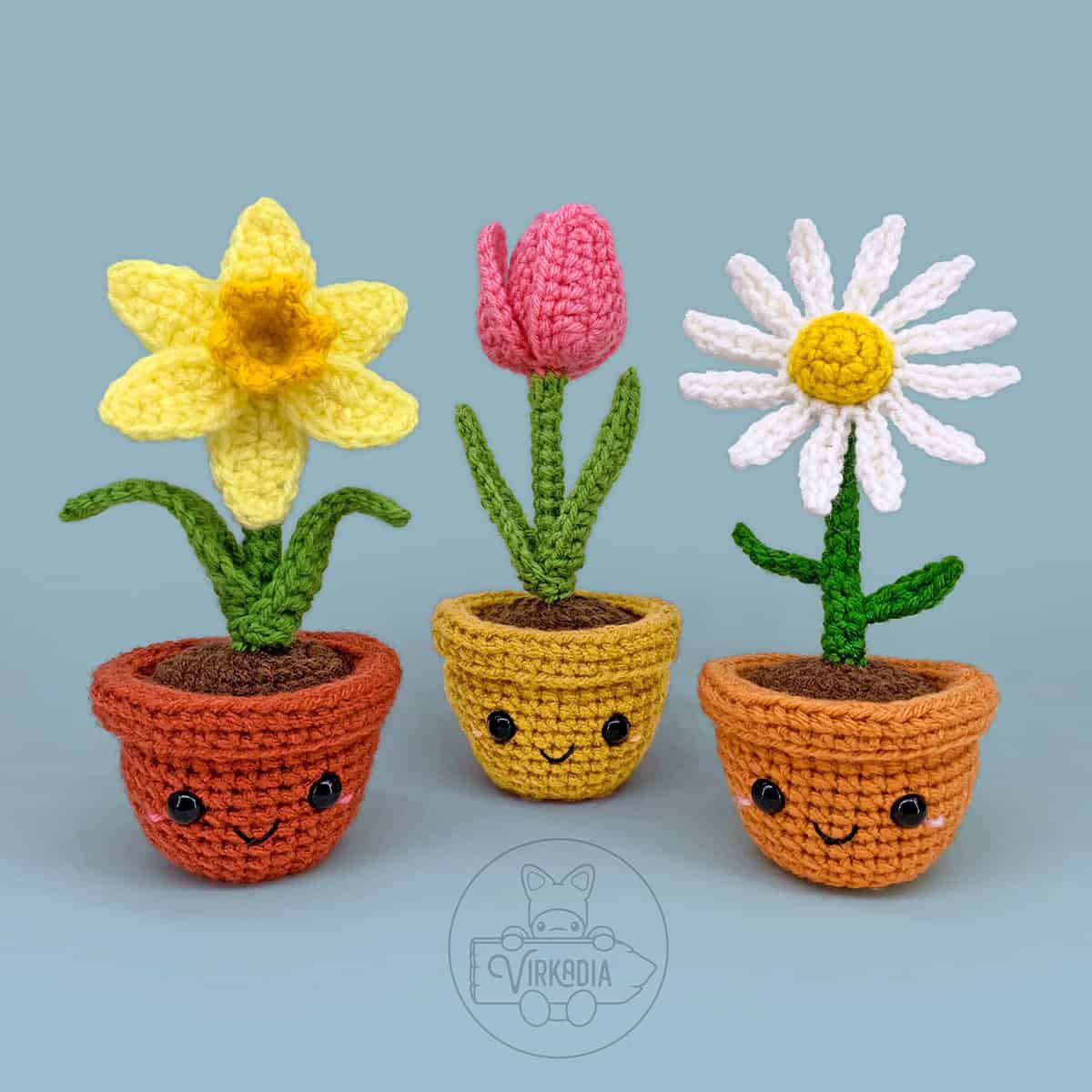

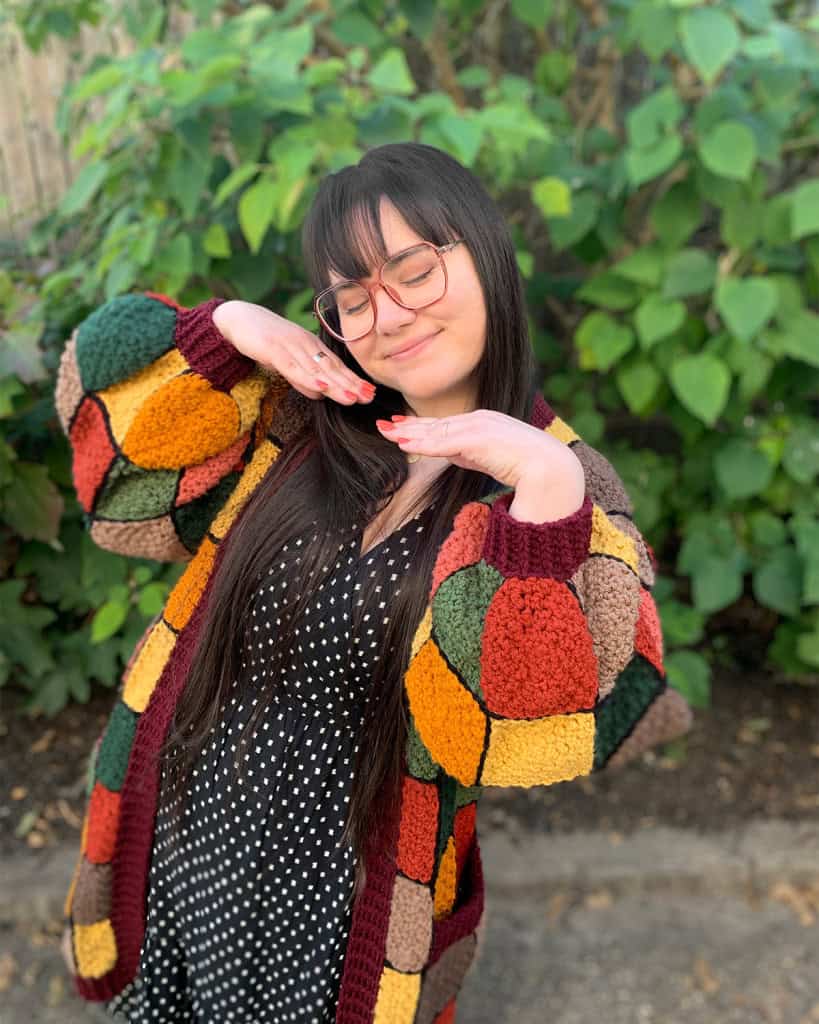
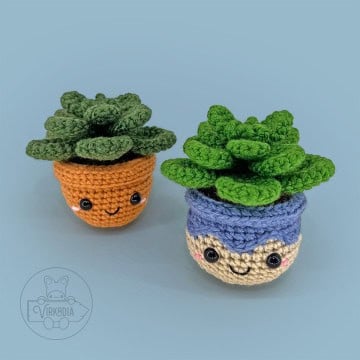

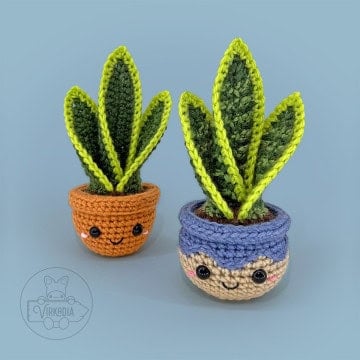
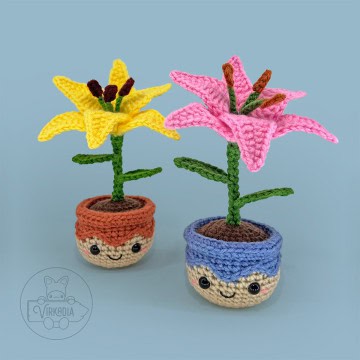
Edna says
Do you have a video for the small flowers your instructor are very complicated and long
Virkadia says
We do not have a video tutorial for the Tulip Cutie at this time, but we can add it to the list of requests—thanks for your feedback!
Lyndsi says
In your picture it looks like the small petals are possibly sewn together just wondering how to go from the picture where you are inserting the wire and petals are all spread out to the display picture at the beginning of this post?
Virkadia says
Hi Lyndsi, thanks for reaching out!
The example tulips in the cover photo are not sewn together—but you can certainly do so if you desire!
The last tutorial photo has the petals spread out only for the purpose of showing you a better visual of where the wire is being inserted. Afterwards, the petals were simply just tilted upwards and back into the position you see in the finished photo.
If you don’t like that the petals can be moved, or if your petals do not stand up on their own (because of looser tension, for example), sewing them into position is a great option to consider!
Hope this helps!